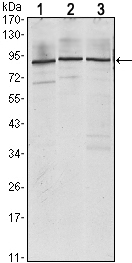IMP-3 Monoclonal Antibody
- Catalog No.:YM0374
- Applications:WB;IHC;IF;ELISA
- Reactivity:Human
- Target:
- IMP-3
- Gene Name:
- IGF2BP3
- Protein Name:
- Insulin-like growth factor 2 mRNA-binding protein 3
- Human Gene Id:
- 10643
- Human Swiss Prot No:
- O00425
- Mouse Swiss Prot No:
- Q9CPN8
- Immunogen:
- Purified recombinant fragment of human IMP-3 expressed in E. Coli.
- Specificity:
- IMP-3 Monoclonal Antibody detects endogenous levels of IMP-3 protein.
- Formulation:
- Liquid in PBS containing 50% glycerol, 0.5% BSA and 0.02% sodium azide.
- Source:
- Monoclonal, Mouse
- Dilution:
- WB 1:500 - 1:2000. IHC 1:200 - 1:1000. ELISA: 1:10000.. IF 1:50-200
- Purification:
- Affinity purification
- Storage Stability:
- -15°C to -25°C/1 year(Do not lower than -25°C)
- Other Name:
- IGF2BP3;IMP3;KOC1;VICKZ3;Insulin-like growth factor 2 mRNA-binding protein 3;IGF2 mRNA-binding protein 3;IMP-3;IGF-II mRNA-binding protein 3;KH domain-containing protein overexpressed in cancer;hKOC;VICKZ family member 3
- Molecular Weight(Da):
- 64kD
- References:
- 1. Clin Cancer Res. 2008 Mar 15;14(6):1701-6.
2. Hepatology. 2008 Oct;48(4):1118-27.
- Background:
- The protein encoded by this gene is primarily found in the nucleolus, where it can bind to the 5' UTR of the insulin-like growth factor II leader 3 mRNA and may repress translation of insulin-like growth factor II during late development. The encoded protein contains several KH domains, which are important in RNA binding and are known to be involved in RNA synthesis and metabolism. A pseudogene exists on chromosome 7, and there are putative pseudogenes on other chromosomes. [provided by RefSeq, Jul 2008],
- Function:
- disease:Autoantibodies against IGF2BP3 are detected in sera from some patients with a variety of carcinomas.,function:RNA-binding protein that act as a regulator of mRNA translation and stability. Binds to the 5'-UTR of the insulin-like growth factor 2 (IGF2) mRNAs. Binds to sequences in the 3'-UTR of CD44 mRNA.,similarity:Belongs to the RRM IMP/VICKZ family.,similarity:Contains 2 RRM (RNA recognition motif) domains.,similarity:Contains 4 KH domains.,subcellular location:Found in lamellipodia of the leading edge, in the perinuclear region, and beneath the plasma membrane. The subcytoplasmic localization is cell specific and regulated by cell contact and growth. Localized at the connecting piece and the tail of the spermatozoa. Colocalized with CD44 mRNA in RNP granules.,subunit:Homodimer and multimer.,tissue specificity:Expressed in fetal liver, fetal lung, fetal kidney, fetal thymus, fe
- Subcellular Location:
- Nucleus. Cytoplasm. Cytoplasm, P-body . Cytoplasm, Stress granule . Found in lamellipodia of the leading edge, in the perinuclear region, and beneath the plasma membrane. The subcytoplasmic localization is cell specific and regulated by cell contact and growth. Localized at the connecting piece and the tail of the spermatozoa. Colocalized with CD44 mRNA in RNP granules. In response to cellular stress, such as oxidative stress, recruited to stress granules.
- Expression:
- Expressed in fetal liver, fetal lung, fetal kidney, fetal thymus, fetal placenta, fetal follicles of ovary and gonocytes of testis, growing oocytes, spermatogonia and semen (at protein level). Expressed in cervix adenocarcinoma, in testicular, pancreatic and renal-cell carcinomas (at protein level). Expressed ubiquitously during fetal development at 8 and 14 weeks of gestation. Expressed in ovary, testis, brain, placenta, pancreatic cancer tissues and pancreatic cancer cell lines.
Expression of IMP3 as a marker for predicting poor outcome in gastroenteropancreatic neuroendocrine neoplasms. Oncology Letters 2017 Feb 14 IHC Human 1:200 gastroenteropancreatic neuroendocrine neoplasm (GEP‑NEN)
- June 19-2018
- WESTERN IMMUNOBLOTTING PROTOCOL
- June 19-2018
- IMMUNOHISTOCHEMISTRY-PARAFFIN PROTOCOL
- June 19-2018
- IMMUNOFLUORESCENCE PROTOCOL
- September 08-2020
- FLOW-CYTOMEYRT-PROTOCOL
- May 20-2022
- Cell-Based ELISA│解您多样本WB检测之困扰
- July 13-2018
- CELL-BASED-ELISA-PROTOCOL-FOR-ACETYL-PROTEIN
- July 13-2018
- CELL-BASED-ELISA-PROTOCOL-FOR-PHOSPHO-PROTEIN
- July 13-2018
- Antibody-FAQs
- Products Images

- Western Blot analysis using IMP-3 Monoclonal Antibody against Jurkat (1), K562 (2) and NTERA-2 (3) cell lysate.

- Immunohistochemistry analysis of paraffin-embedded lung cancer (left) and colon tumour tissues (right) with DAB staining using IMP-3 Monoclonal Antibody.



